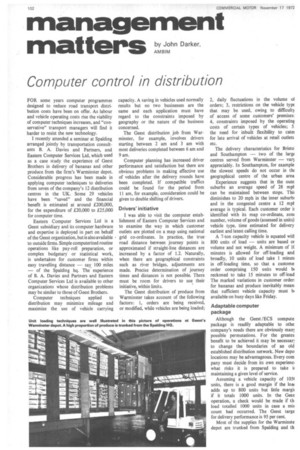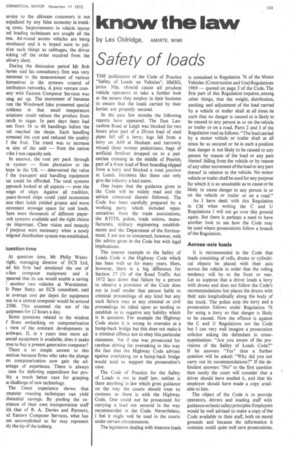management matters
Page 108

Page 109

If you've noticed an error in this article please click here to report it so we can fix it.
by John Darker,
AMBIM
Computer control in distribution
FOR some years computer programmes designed to reduce road transport distribution costs have been on offer. As labour and vehicle operating costs rise the viability of computer techniques increases, and "conservative" transport managers will find it harder to resist the new technology.
I recently attended a seminar at Spalding arranged jointly by transportation consultants B. A. Davies and Partners, and Eastern Computer Services Ltd, which used as a case study the experience of Geest Brothers in delivery of bananas and other produce from the firm's Warminster depot. Considerable progress has been made in applying computer techniques to deliveries from seven of the company's 12 distribution centres in the UK. Some 29 vehicles have been "saved" and the financial benefit is estimated at around £200,000, for the expenditure of £20,000 to £25,000 for computer time.
Eastern Computer Services Ltd is a Geest subsidiary and its computer hardware and expertise is deployed in part on behalf of the Geest organization, but is also available to outside firms. Simple computerized routine operations like pay-roll preparation, or complex budgetary or statistical work, is undertaken for customer firms within easy travelling distance — say 100 miles — of the Spalding hq. The experience of B. A. Davies and Partners and Eastern Computer Services Ltd is available to other organizations whose distribution problems may be similar to those of Geest Brothers.
Computer techniques applied to distribution may minimize mileage and maximize the use of vehicle carrying capacity. A saving in vehicles used normally results but no two businesses are the same and each application must have regard to the constraints imposed by geography or the nature of the business concerned.
The Geest distribution job from Warminster, for example, involves drivers starting between 2 am and 3 am with most deliveries completed between 6 am and 9 am.
Computer planning has increased driver performance and satisfaction but there are obvious problems in making effective use of vehicles after the delivery rounds have been completed. If compatible traffics could be found for the period from 11 am, for example, consideration could be given to double shifting of drivers.
Drivers' initiative I was able to visit the computer establishment of Eastern Computer Services and to examine the way in which customer outlets are plotted on a map using national grid co-ordinates. In practice, the true road distance between journey points is approximated if straight-line distances are increased by a factor of 1.2. Naturally, when there are geographical constraints such as river bridges, adjustments are made. Precise determination of journey times and distances is not possible. There must be room for drivers to use their initiative, within limits.
The Geest distribution of produce from Warminster takes account of the following factors: 1, orders are being received, or modified, while vehicles are being loaded; 2, daily fluctuations in the volume of orders; 3, restrictions on the vehicle type that may be used, owing to difficulty of access of some customers' premises: 4, constraints imposed by the operating costs of certain types of vehicles; 5. the need for inbuilt flexibility to catet for late arrival of vehicles at retail outlets etc.
The delivery characteristics for Bristo and Southampton — two of the largt centres served from Warminster — vary appreciably. In Southampton, for example the slowest speeds do not occur in tilt geographical centre of the urban area Experience suggests that in the oute suburbs an average speed of 28 mpl can be maintained between stops. Thi: diminishes to 20 mph in the inner suburb: and in the congested centre a 12 mpl average is typical. Each customer order identified with its map co-ordinate, zont number, volume of goods (assessed in units) vehicle type, time estimated for delivery earliest and latest calling time.
A 7-ton capacity vehicle is equated wit} 800 units of load — units are based or volume and not weight. A minimum of a minutes is allowed for off-loading and broadly, 10 units of load take 1 minut4 in off-loading time, so that a custome order comprising 150 units would be reckoned to take 15 minutes to off-load The marked variations in customer orden for bananas and produce inevitably mean! that sufficient vehicle capacity must 134 available on busy days like Friday.
Adaptable computer package Although the Geest /ECS compute package is readily adaptable to othe. company's needs there are obviously man■ possible permutations. For the greates benefit to be achieved it may be necessar■ to change the boundaries of an old established distribution network. New depo locations may be advantageous. Every corn pany must decide from its own experienel what risks it is prepared to take ii maintaining a given level of service.
Assuming a vehicle capacity of 1051 units, there is a good margin if the low adds up to 800 units but little margii if it totals 1000 units. In the Gees operation, a check would be made if th. load totalled 1000 units in case a mis count had occurred. The Geest targe for delivery performance is 95 per cent.
Most of the supplies for the Warminste depot are trunked from Spalding and th ervice to the ultimate customers is not Prejudiced by any false economy in trunkrig costs. Improvements in vehicle layout nd loading techniques are sought all the ime. All-round access vehicles are being atroduced and it is hoped soon to palstize such things as cabbages, the driver licking off the order required from the elivery sheet.
During the discussion period Mr Bob )avies said his consultancy firm was very nerested in the measurement of various ltematives in the systems control of istribution networks. A joint venture cornany with Eastern Computer Services was eing set up. The movement of bananas i.om the Windward Isles presented special roblems in that small temperature ariations could reduce the product from larch to sugar. In past days there had eon from 36 to 40 handlings before the -uit reached the shops. Each handling icreased the cost and reduced the quality f the fruit. The trend was to increase le size of the unit — from the carton 3 the 1-ton capacity unit.
In essence, the cost per pack through le system — from plantation to the hops in the UK — determined the value f the transport and handling equipment aat could be afforded. The total systems pproach looked at all aspects — even the esign of ships. Against all tradition, luare-bowed ships could yield economies ince their holds yielded greater and more onvenient stowage space for unit loads. here were thousands of different paperFork systems available and the right choice ras important. Clear vision and tenacity f purpose were necessary when a newly esigned distribution system was established.
tuesti on time At question time, Mr Philip Warnsright, managing director of ECS Ltd, Lid his firm had simulated the use of a-line computer equipment and it apeared that its use would enable a saving 7 another two vehicles at Warminster. 1r Peter Batty, an ECS consultant, said le average cost per depot for equipment nes to a central computer would be around 2500. This assumed the use of the quipment for 12 hours a day.
Some questions related to the wisdom f firms embarking on computerization view of the constant developments in ardware. If, in x years time more adanced equipment is available, does it make !lase to buy a present generation computer? There is no simple answer to this uestion because firms who take the plunge ito computerization now gain the adantage of experience. There is always case for deferring expenditure but posbly a much better case for grasping le challenge of new technology.
The Geest experience shows that 3mputer routeing techniques can yield ibstantial savings. By pooling the extrience of their own transportation staff ith that of B. A. Davies and Partners, ad Eastern Computer Services, what has 3en accomplished so far may represent illy the tip of the iceberg.
































































































































































